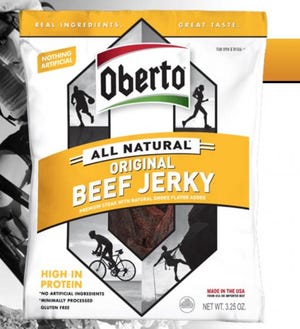3 ways the beef industry could better market beef jerky
August 25, 2015

Our family is a big fan of beef jerky. It’s a quick and easy snack to take on the go, and it’s a healthy, protein-packed meal when we’re in a hurry and don’t want to slow down for lunch. During fall harvest, I send my husband to the field with several sticks of beef jerky to keep him fueled up for the many hours spent in the tractor, and my 14-month-old daughter Scarlett loves gnawing on beef sticks during long car rides.
Despite my family’s love for beef jerky snacks, apparently jerky isn’t the go-to snack for most Americans, says Elaine Watson for Food Navigator USA.
Watson writes, “Most Americans eat meat. But only a small percentage eats meat snacks. So does this disconnect simply reflect the fact that beef doesn’t pair too well with a mid-morning mocha-latte, or is it proof of a huge, still largely untapped, market opportunity?”
Fortunately, in the last five years, jerky demand has grown 61%, and meat snacks and jerky sales grew about 12% in dollars in 2014, according to the article. Watson shares three ways the meat industry should capitalize on market convenience meat products and predicts why the renewed interest in beef snacks is happening. Here is a list of her insights and strategies:
1. Americans are looking to increase their protein intake.

Photo Credit: Oberto http://www.oberto.com/products/#Original_Beef
Diets such as Atkins, Protein Power, and Paleo are centered around high-quality proteins, and as a result, folks are looking for quick and easy options to get more protein into their diets.
“Beef jerky is the ultimate health snack,” says David Lakey, Oberto’s vice president of marketing. “It’s extremely low calorie, virtually no fat, high protein and very low carb, so it offers all the things people say they want; we just need to get consumers to understand that, and that’s the challenge for the whole industry.”
2. Beef jerky isn’t just for men anymore.
Traditionally, beef jerky has been marketed to men, but Watson says upmarket brands like EPIC and KRAVE appeal to new audiences such as women, foodies, and athletes, changing the perception of beef snacks overall — from high-sodium, poor ingredient foods, to high-quality, low-fat, low-carb snacks for the modern woman and athlete.
“Oberto is targeting physically active men and women with a little higher income that are interested in nutrition, and we sell well across multiple retailers from Walmart and Target to Dick’s Sporting Goods,” says Lakey.
3. Retailers are more savvy about marketing meat snacks.
Due to the rising cost of beef, moving beef snack products can be difficult; however, retailers are starting to merchandise their jerky options better, says Lakey.
“If you position the jerky next to candy, gum and magazines near checkout, you see a big increase in sales,” says Lakey.
Lakey is hoping to see the U.S. beef herd expand, so Oberto can continue to buy high-quality beef for its jerky products. Unfortunately, many merchandisers in this category are having to buy lower quality beef, reduce packaging size, increase prices, or take a margin hit.
“Some players are also responding by buying lesser quality meat at a lower price, but we’re just crossing our fingers that the U.S. herds will be rebuilt.”
Are you a fan of beef jerky and other meat snacks? How can the industry better sell this beef merchandise? Share your strategies in the comments section below.
The opinions of Amanda Radke are not necessarily those of beefmagazine.com or Penton Agriculture.
You might also like:
3 non-traditional feedstuff options to consider for your cow herd
Picture perfect summer grazing scenes from readers
You May Also Like


.png?width=300&auto=webp&quality=80&disable=upscale)
